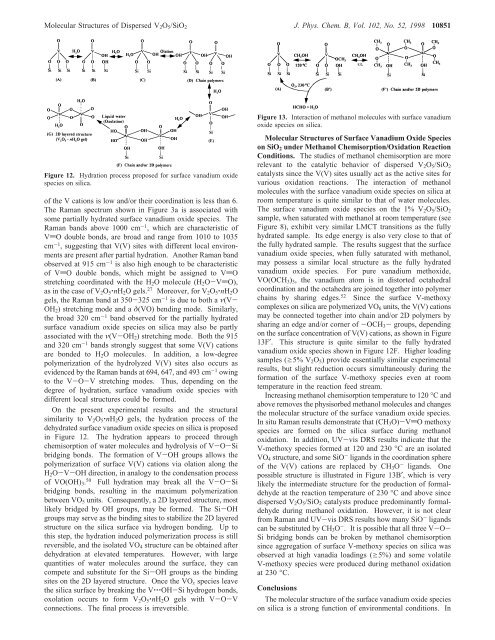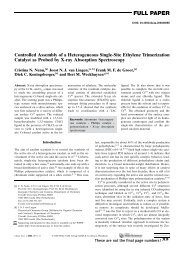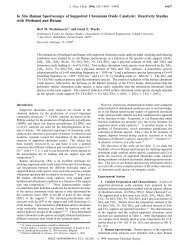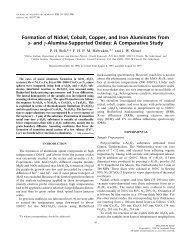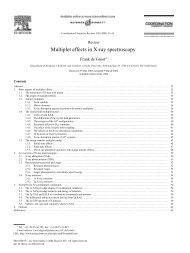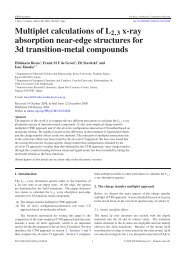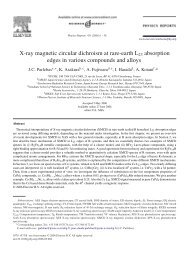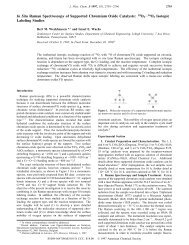<strong>Molecular</strong> <strong>Structures</strong> <strong>of</strong> Dispersed V 2 O 5 /SiO 2 J. Phys. Chem. B, Vol. 102, No. 52, 1998 10851Figure 12. Hydration process proposed for surface vanadium oxidespecies on silica.<strong>of</strong> the V cations is low and/or their coordination is less than 6.The Raman spectrum shown in Figure 3a is associated withsome partially hydrated surface vanadium oxide species. TheRaman bands above 1000 cm -1 , which are characteristic <strong>of</strong>VdO double bonds, are broad and range from 1010 to 1035cm -1 , suggesting that V(V) sites with different local environmentsare present after partial hydration. Another Raman bandobserved at 915 cm -1 is also high enough to be characteristic<strong>of</strong> VdO double bonds, which might be assigned to VdOstretching coordinated with the H 2 O molecule (H 2 O-VdO),as in the case <strong>of</strong> V 2 O 5 ‚nH 2 O gels. 27 Moreover, for V 2 O 5 ‚nH 2 Ogels, the Raman band at 350-325 cm -1 is due to both a ν(V-OH 2 ) stretching mode and a δ(VO) bending mode. Similarly,the broad 320 cm -1 band observed for the partially hydratedsurface vanadium oxide species on silica may also be partlyassociated with the ν(V-OH 2 ) stretching mode. Both the 915and 320 cm -1 bands strongly suggest that some V(V) cationsare bonded to H 2 O molecules. <strong>In</strong> addition, a low-degreepolymerization <strong>of</strong> the hydrolyzed V(V) sites also occurs asevidenced by the Raman bands at 694, 647, and 493 cm -1 owingto the V-O-V stretching modes. Thus, depending on thedegree <strong>of</strong> hydration, surface vanadium oxide species withdifferent local structures could be formed.On the present experimental results and the structuralsimilarity to V 2 O 5 ‚nH 2 O gels, the hydration process <strong>of</strong> thedehydrated surface vanadium oxide species on silica is proposedin Figure 12. The hydration appears to proceed throughchemisorption <strong>of</strong> water molecules and hydrolysis <strong>of</strong> V-O-Sibridging bonds. The formation <strong>of</strong> V-OH groups allows thepolymerization <strong>of</strong> surface V(V) cations via olation along theH 2 O-V-OH direction, in analogy to the condensation process<strong>of</strong> VO(OH) 3 . 50 Full hydration may break all the V-O-Sibridging bonds, resulting in the maximum polymerizationbetween VO 5 units. Consequently, a 2D layered structure, mostlikely bridged by OH groups, may be formed. The Si-OHgroups may serve as the binding sites to stabilize the 2D layeredstructure on the silica surface via hydrogen bonding. Up tothis step, the hydration induced polymerization process is stillreversible, and the isolated VO 4 structure can be obtained afterdehydration at elevated temperatures. However, with largequantities <strong>of</strong> water molecules around the surface, they cancompete and substitute for the Si-OH groups as the bindingsites on the 2D layered structure. Once the VO x species leavethe silica surface by breaking the V‚‚‚OH-Si hydrogen bonds,oxolation occurs to form V 2 O 5 ‚nH 2 O gels with V-O-Vconnections. The final process is irreversible.Figure 13. <strong>In</strong>teraction <strong>of</strong> methanol molecules with surface vanadiumoxide species on silica.<strong>Molecular</strong> <strong>Structures</strong> <strong>of</strong> Surface Vanadium Oxide Specieson SiO 2 under Methanol Chemisorption/Oxidation ReactionConditions. The studies <strong>of</strong> methanol chemisorption are morerelevant to the catalytic behavior <strong>of</strong> dispersed V 2 O 5 /SiO 2catalysts since the V(V) sites usually act as the active sites forvarious oxidation reactions. The interaction <strong>of</strong> methanolmolecules with the surface vanadium oxide species on silica atroom temperature is quite similar to that <strong>of</strong> water molecules.The surface vanadium oxide species on the 1% V 2 O 5 /SiO 2sample, when saturated with methanol at room temperature (seeFigure 8), exhibit very similar LMCT transitions as the fullyhydrated sample. Its edge energy is also very close to that <strong>of</strong>the fully hydrated sample. The results suggest that the surfacevanadium oxide species, when fully saturated with methanol,may possess a similar local structure as the fully hydratedvanadium oxide species. For pure vanadium methoxide,VO(OCH 3 ) 3 , the vanadium atom is in distorted octahedralcoordination and the octahedra are joined together into polymerchains by sharing edges. 52 Since the surface V-methoxycomplexes on silica are polymerized VO 6 units, the V(V) cationsmay be connected together into chain and/or 2D polymers bysharing an edge and/or corner <strong>of</strong> -OCH 3 - groups, dependingon the surface concentration <strong>of</strong> V(V) cations, as shown in Figure13F′. This structure is quite similar to the fully hydratedvanadium oxide species shown in Figure 12F. Higher loadingsamples (g5% V 2 O 5 ) provide essentially similar experimentalresults, but slight reduction occurs simultaneously during theformation <strong>of</strong> the surface V-methoxy species even at roomtemperature in the reaction feed stream.<strong>In</strong>creasing methanol chemisorption temperature to 120 °C andabove removes the physisorbed methanol molecules and changesthe molecular structure <strong>of</strong> the surface vanadium oxide species.<strong>In</strong> situ Raman results demonstrate that (CH 3 O)-VdO methoxyspecies are formed on the silica surface during methanoloxidation. <strong>In</strong> addition, UV-vis DRS results indicate that theV-methoxy species formed at 120 and 230 °C are an isolatedVO 4 structure, and some SiO - ligands in the coordination sphere<strong>of</strong> the V(V) cations are replaced by CH 3 O - ligands. Onepossible structure is illustrated in Figure 13B′, which is verylikely the intermediate structure for the production <strong>of</strong> formaldehydeat the reaction temperature <strong>of</strong> 230 °C and above sincedispersed V 2 O 5 /SiO 2 catalysts produce predominantly formaldehydeduring methanol oxidation. However, it is not clearfrom Raman and UV-vis DRS results how many SiO - ligandscan be substituted by CH 3 O - . It is possible that all three V-O-Si bridging bonds can be broken by methanol chemisorptionsince aggregation <strong>of</strong> surface V-methoxy species on silica wasobserved at high vanadia loadings (g5%) and some volatileV-methoxy species were produced during methanol oxidationat 230 °C.ConclusionsThe molecular structure <strong>of</strong> the surface vanadium oxide specieson silica is a strong function <strong>of</strong> environmental conditions. <strong>In</strong>
10852 J. Phys. Chem. B, Vol. 102, No. 52, 1998 Gao et al.the dehydrated state, the isolated VO 4 species are unique up tomonolayer coverage <strong>of</strong> ∼12 wt % V 2 O 5 (∼2.6 V atoms/nm 2 ).The deposition <strong>of</strong> surface vanadium oxide species consumesmost <strong>of</strong> the surface Si-OH hydroxyls and breaks some surfaceSi-O-Si siloxane bridges. The three-member rings on silicaappear to be the most favorable sites for anchoring the isolated,three-legged (SiO) 3 VdO units. Above monolayer coverage,V 2 O 5 crystallites are formed, possibly with some poorlycrystallized 2D V 2 O 5 patches that possess some interaction withthe silica surface. Hydration dramatically changes the molecularstructure <strong>of</strong> the surface vanadium oxide species, and the degree<strong>of</strong> hydration plays a critical role in determining the specificstructure <strong>of</strong> the vanadium oxide species on the silica surface.During the hydration process, hydrolysis <strong>of</strong> V-O-Si bondsoccurs and V(V) cations may form chain polymers via olation.Full hydration results in maximum polymerization to form chainand/or 2D polymers most likely through V-OH-V bridges.V 2 O 5 ‚nH 2 O gels with independent 2D layers can simply beobtained by adding liquid water to the dispersed V 2 O 5 /SiO 2samples.Upon saturation with methanol molecules at room temperature,the surface vanadium oxide species may form chain and/or 2D polymers through V-OCH 3 -V bridges on the silicasurface. Methanol chemisorption at high temperatures (g120°C) results in isolated, 4-fold coordinated V(V)-methoxy species,which may serve as an intermediate for methanol oxidation.Moreover, alcoholysis <strong>of</strong> the V-O-Si bonds destabilizes thesurface vanadium oxide species, which results in the aggregation<strong>of</strong> the surface vanadium oxide species on silica and production<strong>of</strong> some volatile V-methoxy species during methanol oxidationat high temperatures.Acknowledgment. This work was funded by the U.S.National Science Foundation Grant CTS-9417981. The UVvis-NIRDRS experiments were performed on a Varian Cary5UV-vis-NIR spectrometer that was supported by the U.S.Department <strong>of</strong> Energy, Basic Energy Sciences, Grant DE-FG02-93ER14350. Part <strong>of</strong> the research was carried out at the NationalSynchrotron Light Source, Brookhaven National Laboratory,which is supported by the U.S. Department <strong>of</strong> Energy, Division<strong>of</strong> Materials Sciences and Division <strong>of</strong> Chemical Sciences. Theauthors thank Dr. M. A. Banares for the help with BET surfacearea measurements and chemical analysis.References and Notes(1) Sun, Q.; Jehng, J. M.; Hu, H. H.; Herman, R. G.; Wachs, I. E.;Klier, K. J. Catal. 1997, 165, 91.(2) Irusta, S.; Cornaglia, L. M.; Miro, E. E.; Lombardo, E. A. J. Catal.1995, 156, 167.(3) Banares, M.; Gao, X.; Fierro, J. L. G.; and Wachs, I. E. Stud. Surf.Sci. Catal. 1997, 110, 295.(4) Tanaka, T.; Nishimura, S.; Kawasaki, S.; Ooe, M.; Funabiki, T.;Yoshida, S. J. Catal. 1989, 118, 327.(5) Kaliaguine, S. L.; Shelimov, B. N.; Kazansky, V. B. J. Catal. 1978,55, 384.(6) Anpo, M.; Sunamoto, M.; Che, M. J. Phys. Chem. 1989, 93, 1187.(7) Jonson, B.; Rebenstr<strong>of</strong>, B.; Larsson, R.; Andersson, S. L. J. Chem.Soc., Faraday Trans. 1 1988, 84, 1897.(8) Lische, G.; Hanke, W.; Jerschkewitz, H. G.; Ohlmann, J. J. Catal.1985, 91, 54.(9) Iwamoto, M.; Hirata, J.; Matsukami, K.; Kagawa, S. J. Phys. Chem.1983, 87, 903.(10) (a) Schraml-Marth, M.; Wokaun, A.; Pohl, M.; Krauss, H.-L. J.Chem. Soc., Faraday Trans. 1991, 87, 2635. (b) Scharf, U.; Schraml-Marth,M.; Wokaun, Baiker, A. J. Chem. Soc., Faraday Trans. 1991, 87, 3299.(11) (a) <strong>In</strong>umaru, K.; Okuhara, T.; Misono, M.; Matsubayashi, N.;Shimada, H.; Nishijima, A. J. Chem. Soc., Faraday Trans. 1992, 88, 625.(b) <strong>In</strong>umaru, K.; Okuhara, T.; Misono, M. J. Phys. Chem. 1991, 95, 4826.(c) <strong>In</strong>umaru, K.; Misono, M.; Okuhara, T. Appl. Catal. A,1997, 149, 133.(12) Das, N.; Eckert, H.; Hu, H.; Wachs, I. E.; Walzer, J. F.; Feher, F.J. J. Phys. Chem. 1993, 97, 8240.(13) Went, G. T.; Oyama, S. T.; Bell, A. T. J. Phys. Chem. 1990, 94,4240.(14) Roozeboom, F.; Mittelmeljer-Hazeleger, M. C.; Moulijn, J. A.;Medema, J.; de Beer, V. H. J.; Gellings, P. J. J. Phys. Chem. 1980, 84,2783.(15) (a) Yoshida, S.; Tanaka, T.; Nishimura, Y.; Mizutani, H.; Funabiki,T. the Proc. 9th <strong>In</strong>t. Congr. Catal. 1988, 3, 1473. (b) Yoshida, S.; Tanaka,T.; Hanada, T.; Hiraiwa, T.; Kanai, H.; Funabiki, T. Catal. Lett. 1992, 12,277. (c) Tanaka, T.; Yamashita, H.; Tsuchitani, R.; Funabiki, T.; Yoshida,S. J. Chem. Soc., Faraday Trans. 1 1988, 84, 2987.(16) Arena, F.; Frusteri, F.; Martra, G.; Coluccia, S.; Parmaliana, A. J.Chem. Soc., Faraday Trans. 1997, 93, 3849.(17) Hazenkamp, M. F.; Blasse, G. J. Phys. Chem. 1992, 96, 3442.(18) Deo, G.; Wachs, I. E. J. Phys. Chem. 1991, 95, 5889.(19) Gao, X.; Bare, R. S.; Fierro, J. L. G.; Banares, M.; Wachs, I. E. J.Phys. Chem. B 1998, 102, 5653.(20) Morrow, B. A.; Mcfarlan, A. J. J. Non-Cryst. Solids 1990, 120,61.(21) Jehng, J. M.; Hu, H.; Gao, X.; Wachs, I. E. Catal. Today 1996,28, 335.(22) Delgass, W. N.; Haller, G. L.; Kellerman, R.; Lunsford, J. H.Spectroscopy in Heterogeneous Catalysis; Academic Press: New York,1979.(23) (a) Tallant, D. R.; Bunker, B. C.; Brinker, C. J.; Balfe, C. A. Mater.Res. Soc. Symp. Proc. 1986, 73, 261. (b) Stolen, R. H.; Walrafen, G. E. J.Chem. Phys. 1976, 64, 2623. (c) Brinker, C. J.; Tallant, D. R.; Roth, E. P.;Ashley, C. S. Mater. Res. Soc. Symp. Proc. 1986, 61, 387.(24) Brinker, C. J.; Kirkpatrick, R. J.; Tallant, D. R.; Bunker, B. C.;Montez, B. J. Non-Cryst. Solids 1988, 99, 418.(25) MacMillan, P. Am. Mineral. 1986, 69, 622.(26) Hardcastle, F.; Wachs, I. E. J. Phys. Chem. 1991, 95, 5031.(27) (a) Abello, L.; Husson, E.; Repelin, Y.; Lucazeau, G. J. Solid StateChem. 1985, 56, 379. (b) Repelin, Y.; Husson, E.; Abello, L.; Lucazeau,G. Spectrochim. Acta, 1985, 41A, 993.(28) Ray, W. J.; Post, C. B. Biochemistry 1990, 29, 2779.(29) (a) Sanderson, R. T. J. Chem. Educ. 1988, 65, 113. (b) Sanderson,R. T. J. Chem. Educ. 1988, 65, 227. (c) Sanderson, R. T. Polar CoValence;Academic Press: New York, 1983.(30) Jehng, J. M.; Deo, G.; Weckhuysen, B. M.; Wachs, I. E. J. Mol.Catal. 1996, 110, 41.(31) Barraclough, C. G.; Bradley, D. C.; Lewis, J.; Thomas, I. M. J.Chem. Soc. 1961, 2601.(32) Wright, A. C. Philos. Mag. B 1984, 50, L23.(33) Marumo, F.; Isobe, M.; Iwai, S.; Kondo, Y. Acta Crystallogr. 1974,B30, 1628.(34) Evans, H. T. Z. Kristallogr. 1960, 114, 257.(35) Nabavi, M.; Taulelle, F.; Sanchez, C.; Verdaguer, M. J. Phys. Chem.Solids 1990, 51, 1375.(36) Ng, H. N.; Calvo, C. Can. J. Chem. 1972, 50, 3619.(37) (a) Sam, D. S. H.; Soenen, V.; Volta, J. C. J. Catal. 1990, 123,417. (b) Busca, G. Ricchiardi, G.; Sam, D. S. H.; Volta, J. C. J. Chem.Soc., Faraday Trans. 1994, 90, 1161.(38) Gopal, R.; Calvo, C. Acta Crystallogr. 1974, B30, 2491.(39) Krishnamachari, N.; Calvo, C. Can. J. Chem. 1971, 49, 1629.(40) Khan, G. A.; Hogarth, C. A. J. Mater. Sci. 1991, 26, 412.(41) Fiermans, L.; Vennik, J. Surf. Sci. 1971, 24, 541.(42) Karvaly, B.; Hevesi, I. Z. Naturforsch. Teil A 1971, 26, 245.(43) Klier, K.; Zettlemoyer, A. C. J. Colloid <strong>In</strong>terface Sci. 1977, 58,216.(44) Wong, J.; Lytle, F. W.; Messmer, R. P.; Maylotte, D. H. Phys.ReV. B1984, 30, 5596.(45) Deo, G. Ph.D. Thesis, Lehigh University, 1992.(46) Hazenkamp, M. F.; van Duijneveldt, F. B.; Blasse, G. Chem. Phys.1993, 169, 55.(47) Tran, K.; Hanning-Lee, M. A.; Biswas, A.; Stiegman, A. E.; Scott,G. W. J. Am. Chem. Soc. 1995, 117, 2618.(48) Brinker, C. J.; Brow, R. K.; Tallant, D. R.; Kirkpatrick, R. J. J.Non-Cryst. Solids 1990, 120, 26.(49) Vansant, E. F.; Voort, P. V. D.; Vrancken, K. C. Stud. Surf. Sci.Catal. 1995, 93.(50) Livage, J. Chem. Mater. 1991, 3, 578.(51) Stizza, S.; Mancini, G.; Benfatto, M.; Natoli, C. R.; Garcia, J.;Bianconi, A. Phys. ReV. B1989, 40, 12 229.(52) Charles, N.; Caughlan, N.; Smith, H. M.; Watenpaugh, K. <strong>In</strong>org.Chem. 1966, 12, 2131.


